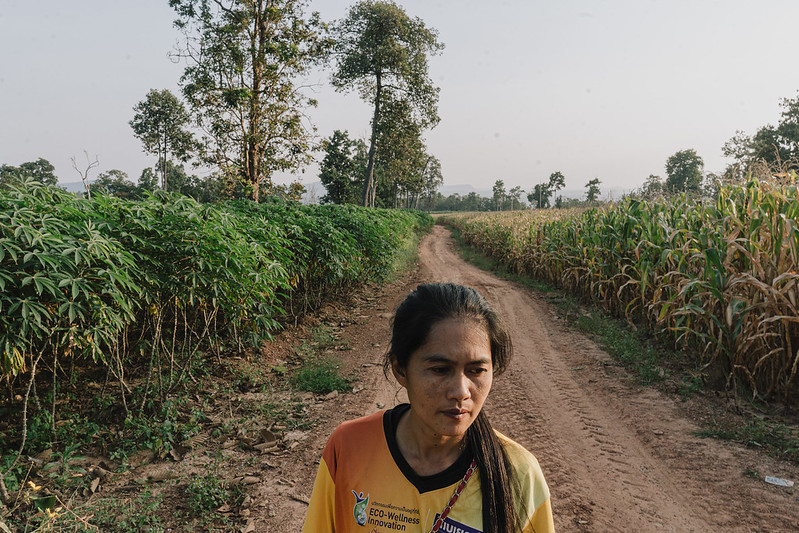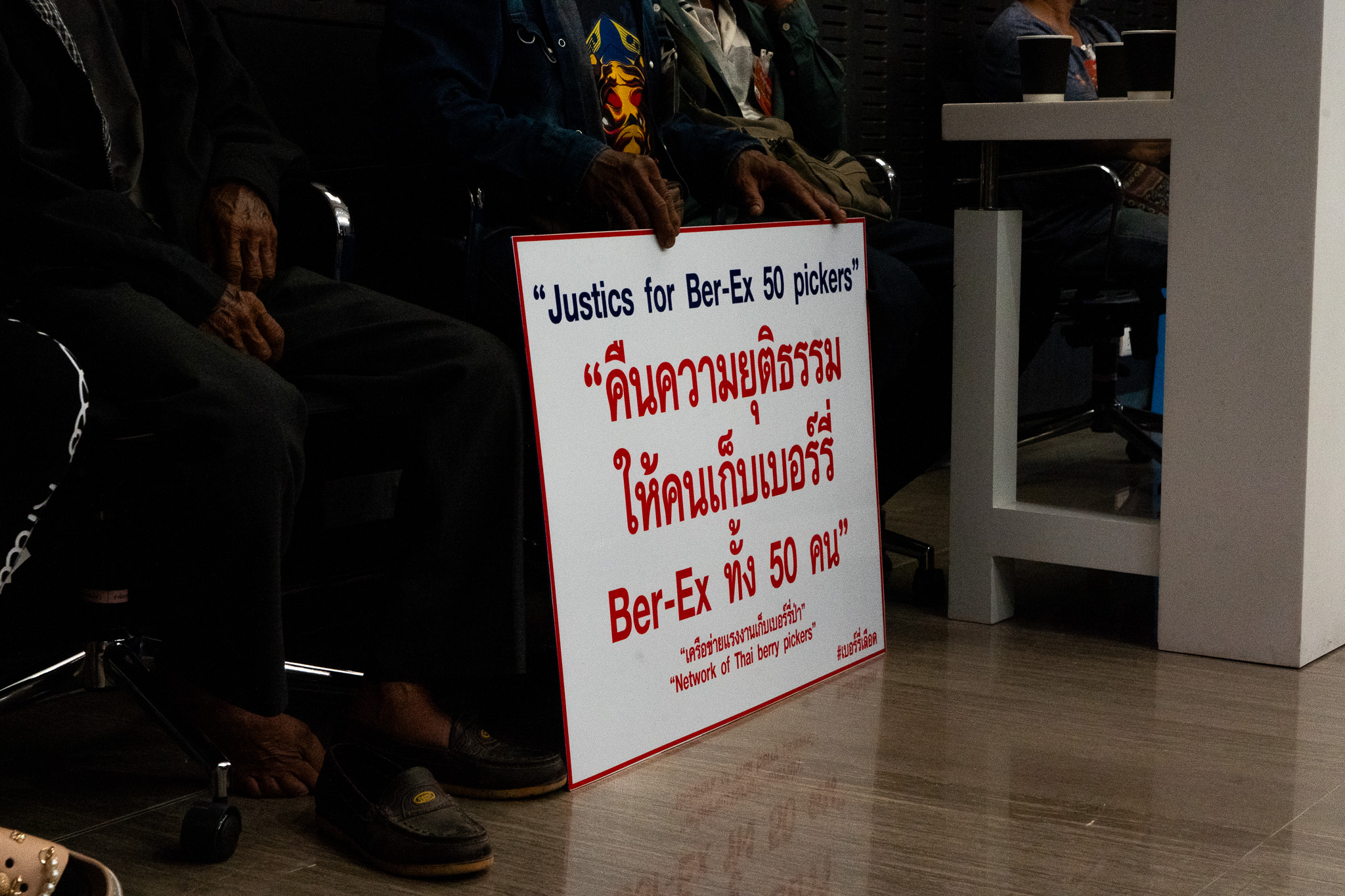SPECIAL SERIES: SWEETNESS & POWER
Thailand’s military government initiated a ten-year sugar plan in 2015 that glowingly envisioned more than doubling sugarcane production and making Thailand the “bio-hub” of Southeast Asia. But in the Northeast where nearly half the country’s sugarcane is produced, growers both large and small are struggling to keep their heads above water as sugar prices have plummeted in the world market over the past three years.
PART VII: Thailand’s vision of a sugary future lets Isaan farmers struggle
Additional material by Teresa Montanero
When the rain arrived in mid-September, the sugarcane of Thawatchai Sriwiboon grew large and green. But as the harvest season closes this year, the farmer in Khon Kaen’s Nong Ruea district has lost any hope in making a profit.
“The price of sugarcane has been low for years, and I had to cut down my farm land from 80 to 40 rai,” Thawatchai says.
Cutting his cultivation from 16 to 6.4 hectares dropped Thawatchai into the ranks of “small” producers, a group that makes up two thirds of the Northeast’s sugarcane farmers.
From 2015 to 2016, the price of sugarcane dropped from 850 baht per ton to 773 baht, causing many farmers to reduce the area of sugarcane growing.
Like many other farmers in the Northeast, Thawatchai switched from rice to sugarcane the late 1990s and made a good profit off his initial 30 rai of land. He even leased another 150 rai to expand his farm.
“In the first few years, I made 600,000 to 700,000 baht per year. Now I only make 300,000 baht. After deducting all the expenses, I don’t make much profit,” the 52-year-old farmer says.
Thawatchai’s farmland is not very far from a sugar mill in Khon Kaen province. Although there is little expense in delivering his sugarcane to the mill, the high costs of production kept him from making a profit.
He started cutting back on the land he leased for sugarcane cultivation every year.
Each planting season, he had to spend 100,000 baht for labor, 200,000 baht to pay back debt to the mill for fertilizers and other chemicals, and another 200,000 baht interest to the Bank of Agriculture and Agricultural Cooperatives (BAAC), not to mention other expenses like weed cutting and renting tractors. The current price of a ton of sugarcane has dropped even further, to around 650 baht.
The math just isn’t adding up for Thawatchai.
“After a year of work, me and my wife don’t have much money left. But we have no way out,” Thawatchai says, discouraged. “We have to deal with the fact that the price of sugarcane is going down.”

A sugarcane farmer preparing the land to grow sugarcane, Roi Et province. Photo by Mike Eckel.
Can’t live on sugarcane
Because of Isaan‘s dry climate, farmers plant their sugarcane in September or October and harvest in November or December of the following year after 12-14 months. The average input costs at a minimum are 7,000 to 8,000 baht per rai.
Somkit Srinakaew is a 50-year-old farmer from Nam Phong district in Khon Kaen province. His family’s been growing sugarcane since his father’s time on more than 50 rai of land (eight hectare).
“Sugarcane normally will produce a yield of ten tons per rai,” Somkit says. “But if the price remains the same as last season, sugarcane farmers will not be able to survive because they’ll lose money.”
The only thing that has been keeping Isaan’s sugarcane growers afloat is a price-sharing scheme devised by the government in 1984. Producers took a 70/30 percent split with the mills, and also received certain government subsidies.
Sugarcane growers receive a subsidy of 50 baht per ton from a fund supplied by a grower’s association and 60 baht per ton from the government.
Somkit’s family can expect to pay, at the low end, 7,000 baht for inputs per rai. With 50 rai, he’ll have to pay at least 350,000 baht. If his farm produces a yield of 500 tons, he’d make 680 a ton plus the 110 baht per ton in subsidies. At today’s prices, Somkit would make 395,000 baht–a mere 45,000 baht in profit, or almost 1,000 baht per rai. Without the subsidies, he’d be in the hole for 10,000 baht.
In the past few years, though, a trade dispute with Brazil in the World Trade Organization (WTO) has caused the government to float Thai sugar prices on the world market. To be in compliance with the rules of the WTO, the government is also discussing whether or how to assist producers.
Even with the subsidies, Somkit’s family is unable to survive on sugarcane growing. He has needed to supplement income by opening up a chemical fertilizer and herbicides shop.
Somkit is considered as a second-generation sugarcane farmer. He seriously doubts if his son will be the third.

Sugarcane farmers in the Northeast plant their crop in September or October and harvest the following year after 12-14 months. Average input costs are at least 7,000 to 8,000 baht per rai. Sugarcane yields about of ten tons per rai
Big sugarcane growers are somewhat better off
Sugarcane farmers who work more than 200 rai (32 hectare) make up only thirteen percent of all growers in the Northeast. Some have very large farms like Chaiwat Kittiwaraphong, a 49-year-old resident of Nam Phong district in Khon Kaen province who farms 1,200 rai in sugarcane.
“My family has been growing sugarcane for more than 30 years,” he tells The Isaan Record, sitting in the air-conditioned office of the Nam Phong Sugarcane Growers’ Association. “We have our own land as well as the land that we are leasing. The price for sugarcane started at 500-600 baht per ton. Later, the price went up to 1,000 baht, which is enough for farmers to live by.”
World sugar prices peaked in 1980 when sugar was selling at $1,010 USD (about 30,800 baht) per ton. It hit another high in 2011 when it stood $730 USD a ton, and hit another high point in 2016 of $530 USD. It is now at a very low $240 USD (about 7,300 baht) a ton.
Even in hard times like these, if Chaiwat had the same inputs and yield as Somkit and his 50 rai, he would have made 10.8 million baht with his 1,200 rai.
Chaiwat believes that most sugarcane farmers are at their breaking point.
“The price of sugarcane is not stable,” he says. “If I were one of those small-scale farmers, I would have quit. I have seen many farmers who’ve stopped. If the [sugar] price goes down even more, farmers will not be able to survive. Even now people are shifting from sugarcane to growing cassava.”
But Chaiwat says that he’s invested too much into sugar cane to stop now. “I have a machine that cannot be used with other crops. I have to keep fighting.”
Out of touch with economic realities
If the fates of both large and small scale farms are now tied to a low world market price of sugar, it doesn’t seem as if the government has noticed. It still champions a policy that encourages people to reduce the land they used to grow rice and switch to sugarcane. Indeed, the 10-year Cane and Sugar Strategy Plan (2015-2024) envisions a 53-percent increase in the area under sugarcane cultivation by 2024.
The government’s Office of Cane and Sugar Board (OCSB) runs the world of sugar in Thailand. Its secretary-general, Worawan Chid-aroon, has the unenviable task of keeping sugar moving even when it’s become unprofitable.
In a news statement of 17 December 2018, Worawan Chid-aroon tried to clarify the situation on the agency’s website. She said the cost valuation on the production of one ton of sugarcane is 1,041 baht. This is partly due, she said, to the government’s policy that encourages farmers to switch growing off-season rice with sugarcane to increase productivity. But partly due to the policy’s success, the increased production of sugar has lowered the price of sugarcane in 2018/19 to only about 700 baht per ton.
Even with subsidies, she said, farmers “will receive 880-900 baht per ton,” that should be enough to “help mitigate the problems farmers are facing at a good, satisfactory level.”
“We acknowledge and understand that the price of sugarcane is lower than the input cost,” the secretary-general admits.
Thailand produced a record 134 million tons of sugarcane last year, but that good fortune “flooded the global market and caused the price to drop.” Her only hope for the present time is to note that the world price of sugar seems to be higher than first predicted.
Long-term vision rosier than short-term reality
In order to help sugarcane farmers in the short run, the government last year approved a support measure of 6.5 billion baht.
The amount is not small. It would provide producers with 563 baht (about $18 USD) for each of the 11,542,553 rai grown in sugarcane last year. But it might be seen as a subsidy in the eyes of the WTO and a populist handout domestically.
Under the ten-year plan, the buzz words are “Smart Farming” and “Bio Hub.” Smart Farming would “increase the efficiency of the production” by using “modern agriculture.” With Smart Farmers producing more and sweeter sugarcane, new technologies will “push forward the bio-economy” and make Thailand the “Bio Hub of ASEAN” by 2024.
In July 2018, the cabinet approved a 96-billion-baht bio-economy development plan with three pilot areas: the eastern special economic zone (with an estimated investment budget of 9.740 billion baht), the lower northern area (Nakhon Sawan and Kamphaeng Phet, with a budget of 51 billion baht), and the lower Isaan area (Khon Kaen, with a budget of 35.030 billion baht).
Sugarcane farmer groups call for higher prices
According to the Nam Phong Sugarcane Growers’ Association of Khon Kaen province 80 percent of the 8,000 current members complained about the sugarcane price being lower than the input cost. They demanded that the government issue a price guarantee policy for their produce.
“If the government decided to increase the price of sugar and the funding for the farmers, we would be doing fine,” suggests Winyo Wongsa, the secretary of the association.
But any attempt by the government to fix sugar prices or provide help might violate WTO rules.

In February locals in Khon Kaen’s Ban Phai district protested against a sugarcane factory and bioenergy power plant to be built by Mitr Phol Group, Asia’s largest sugar producer.
Concerns about sugarcane’s environmental footprint
Santiparp Siriwattanaphaiboon, an environmental expert from Udon Thani Rajabhat University is concerned that the government’s policy of sugarcane expansion might backfire. In order to achieve a higher yield, farmers will need a larger area which might cause them to plow up paddy fields and forest area to grow sugarcane.
“In some areas in Isaan, 30–50 rai of paddy fields have been plowed, and forests were cut down. This caused degradation of the forest ecosystem. If biodiversity in the area is destroyed, food security within the community will also be affected,” Santiparp says.
Another academic researching the effects of sugarcane and sugar industry in Isaan, Sataporn Roengtam from the Faculty of Humanities and Social Sciences at Khon Kaen University, is also skeptical of the government’s sugarcane policy.
“I want the government to create a true participatory process between the [sugar] company and the people in the area. I want the government to re-evaluate the negative impacts that might occur,” Sataporn says.
Dreaming of a life after sugarcane
Thawatchai, like many other sugarcane farmers in the Northeast, started off growing rice on his 30 rai of land. When the price of rice dropped, sugarcane was an attractive alternative. He was one of the first in the village to make the transition.
He began on his own land and after a few years he was growing 150 rai of sugarcane mostly on rented land.
But it’s been a slow grind. He had made a profit and had a modest debt. But as the years went on, as the prices went up and down, his profits were more and more lost to debt payments and the rising costs of inputs.
One of his children works in Khon Kaen city. One works at the sugar mill. A third is in high school, still at home. The older two have no interest in farming. All they’d seen their entire lives was sugarcane fields. His youngest son, he’s not sure.
Thawatchai’s dream is to return to his original 30-rai plot of land, where he and his wife could have an integrated farm just to support the two of them.
Maybe he can do that in ten years, he says. Ten more years of trying to pay off debt from a livelihood where it often costs more to produce than to sell what he’s been harvesting.
Additional material by Teresa Montanero who majors in Anthropology at Georgetown University and studied about development and human rights issues in the Northeast in spring 2019.




